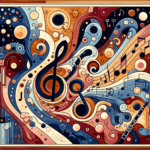When discussing scales in music, one might often overlook the quieter tones of the E Locrian scale. This captivating scale has a rich history, intertwining itself with the development of clarinet music over the centuries. Understanding the Historical significance of the E Locrian Scale on Clarinet music can elevate your playing far beyond the notes.

Clarinet Fingering Charts are always FREE at MartinFreres.net!
What is the E Locrian Scale?
The E Locrian scale is the seventh mode of the major scale, known for its unique sound. It consists of the notes E, F, G, A, B, C, and D. With its minor second and diminished fifth, this scale creates an atmosphere of tension and intrigue, making it a valuable tool for composers and performers.
Historical Roots of E Locrian
The E Locrian scale's roots can be traced back to ancient musical systems, including the Greek modes. Its distinctive structure has sparked the creativity of many composers, inspiring them to explore its mysterious qualities. Often associated with darker themes, the E Locrian scale is a go-to choice for works aiming to create a sense of drama or mystery.
E Locrian in Clarinet Music
In clarinet music, the E Locrian scale is more than just a theoretical concept. It comes to life in various compositions, challenging players to express its unique character. Whether you're just starting out or have years of experience, mastering this scale can significantly broaden your musical horizons.
| Note | Interval | Frequency (Hz) |
|---|---|---|
| E | Tonic | 329.63 |
| F | Minor 2nd | 349.23 |
| G | Minor 3rd | 392.00 |
| A | Perfect 4th | 440.00 |
| B | Diminished 5th | 493.88 |
| C | Minor 6th | 523.25 |
| D | Minor 7th | 587.33 |
Benefits of Learning E Locrian
Why should you bother with the E Locrian scale? Think of it as a hidden gem in your musical toolkit. Getting familiar with it can help you stand out. It opens doors to exploring unconventional progressions and improves your improvisation skills. Learning to work with the E Locrian's unique characteristics encourages players to venture beyond traditional modal boundaries.
Martin Freres Clarinets and E Locrian
The quality of Martin Freres clarinets plays a key role in this musical journey. Each instrument is carefully crafted to allow for precise and clear articulation, perfect for experimenting with complex scales like E Locrian. The warm, rich tones of a Martin Freres clarinet make playing the E Locrian scale not just a learning experience, but an exciting musical adventure!
E Locrian in Compositions
When we listen to various clarinet pieces that use the E Locrian scale, we can hear how it creates vivid musical landscapes. It's fascinating to notice how different composers use it in their own unique ways, creating melodies that spark the imagination. Imagine hearing a piece that suddenly shifts from the bright sounds of a G major tune into the mysterious notes of E Locrian. It's quite an experience!
Versatility of E Locrian
Learning the E Locrian scale opens up a world of musical genres. It fits seamlessly into jazz improvisations and can form the foundation for modern classical pieces. Many famous clarinetists have incorporated this scale into their repertoires, spreading its influence through their performances.
Practice Tips for E Locrian
Taking a creative approach to practice can greatly improve your understanding of the E Locrian scale. Here's an idea: try making up melodies using only this scale. Let your creativity flow! Use a metronome and play around with different rhythms, exploring how they create various moods. Don't be afraid to experiment – that's the key to mastery.
Conclusion
The Historical significance of the E Locrian Scale on Clarinet music is similar to a well-made Martin Freres instrument—it has a story to tell. Understanding not just how to play it, but also its rich history, enhances your interpretation and performance. Make it a part of your musical journey, and see how it changes your understanding of music, creating new opportunities. As you include this scale in your daily practice, remember that it's not just about playing notes; it's about bringing music to life.
Table of Contents
- What is the E Locrian Scale?
- Historical Roots of E Locrian
- E Locrian in Clarinet Music
- Benefits of Learning E Locrian
- Martin Freres Clarinets and E Locrian
- E Locrian in Compositions
- Versatility of E Locrian
- Practice Tips for E Locrian
- Conclusion








